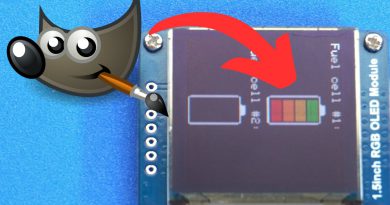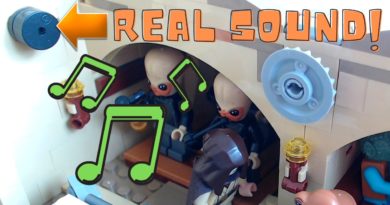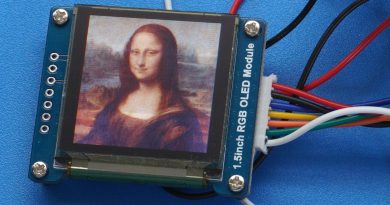Arduino + TFT Display With Multicolor Sprites (ST7735S 80×160 Module)
In this video you can see how I created a mock up display of the classic Nintendo Donkey Kong game on an Arduino Uno. The display module used is an ST7735S 80×160 TFT screen sourced from eBay.
Arduino Uno sketch source code is further down the page…
The graphics were created using the Adafruit GFX library and the Adafruit ST7735 and ST7789 library.
I didn’t have too many problems using this module. The main issue was the color codes were different to those specified in the GFX library. There is also some flickering at the top and right hand side of the display.
Questions or suggestions? Leave a comment below or on the Youtube video’s page. I’m still a C noob so I’m sure there’s a better way of doing everything. Lego Bro Thor was really pleased with his new games console, even if the ST7735S is slightly too big to fit in a 4×3 Lego window frame. I’m also impressed with the refresh rate of this screen. The motion looks pretty smooth in real life.
Useful Resources
- image2cpp (convert images to C format for use on Arduino Uno and Arduino Nano microcontroller displays).
- How to sort out ST7735 colour corruption issues (useful if you buy your ST7735S from eBay!).
Incidentally my hardware graphics were captured on a Canon EOS 550D with a 60mm EF-S macro lens.
Source Code
#include <HID.h>
/**************************************************************************
This is a library for several Adafruit displays based on ST77* drivers.
Works with the Adafruit 1.8" TFT Breakout w/SD card
----> http://www.adafruit.com/products/358
The 1.8" TFT shield
----> https://www.adafruit.com/product/802
The 1.44" TFT breakout
----> https://www.adafruit.com/product/2088
The 1.14" TFT breakout
----> https://www.adafruit.com/product/4383
The 1.3" TFT breakout
----> https://www.adafruit.com/product/4313
The 1.54" TFT breakout
----> https://www.adafruit.com/product/3787
The 1.69" TFT breakout
----> https://www.adafruit.com/product/5206
The 2.0" TFT breakout
----> https://www.adafruit.com/product/4311
as well as Adafruit raw 1.8" TFT display
----> http://www.adafruit.com/products/618
Check out the links above for our tutorials and wiring diagrams.
These displays use SPI to communicate, 4 or 5 pins are required to
interface (RST is optional).
Adafruit invests time and resources providing this open source code,
please support Adafruit and open-source hardware by purchasing
products from Adafruit!
Written by Limor Fried/Ladyada for Adafruit Industries.
MIT license, all text above must be included in any redistribution
**************************************************************************/
#include <Adafruit_GFX.h> // Core graphics library
#include <Adafruit_ST7735.h> // Hardware-specific library for ST7735
#include <Adafruit_ST7789.h> // Hardware-specific library for ST7789
#include <SPI.h>
#if defined(ARDUINO_FEATHER_ESP32) // Feather Huzzah32
#define TFT_CS 14
#define TFT_RST 15
#define TFT_DC 32
#elif defined(ESP8266)
#define TFT_CS 4
#define TFT_RST 16
#define TFT_DC 5
#else
// For the breakout board, you can use any 2 or 3 pins.
// These pins will also work for the 1.8" TFT shield.
#define TFT_CS 10
#define TFT_RST 8 // Or set to -1 and connect to Arduino RESET pin
#define TFT_DC 9
#endif
// OPTION 1 (recommended) is to use the HARDWARE SPI pins, which are unique
// to each board and not reassignable. For Arduino Uno: MOSI = pin 11 and
// SCLK = pin 13. This is the fastest mode of operation and is required if
// using the breakout board's microSD card.
// For 1.44" and 1.8" TFT with ST7735 use:
Adafruit_ST7735 tft = Adafruit_ST7735(TFT_CS, TFT_DC, TFT_RST);
// For 1.14", 1.3", 1.54", 1.69", and 2.0" TFT with ST7789:
//Adafruit_ST7789 tft = Adafruit_ST7789(TFT_CS, TFT_DC, TFT_RST);
// OPTION 2 lets you interface the display using ANY TWO or THREE PINS,
// tradeoff being that performance is not as fast as hardware SPI above.
//#define TFT_MOSI 11 // Data out
//#define TFT_SCLK 13 // Clock out
//If you buy your TFT from eBay don't be surprised if the colours are messed up.
//I found this code sorted my colours out. The library's colours (e.g. ST77XX_CYAN)
//were all wrong on my particular TFT screen
//Credit for sorting this:
//https://forum.arduino.cc/t/colour-confusion-issue-with-unbranded-160x80-tft-and-adafruit-library/604752/12
#define BLACK 0xFFFF
#define BLUE 0x07FF
#define RED 0xFFE0
#define GREEN 0xF81F
#define CYAN 0x001F
#define MAGENTA 0x07E0
#define YELLOW 0xF800
#define WHITE 0x0000
#define DGRAY 0x528A
#define LGRAY 0x2945
#define ORANGE 0xFC02
//Define a vertical start position which makes it easy to move everything for specific displays
#define START_POS 2
// For ST7735-based displays, we will use this call
//Adafruit_ST7735 tft = Adafruit_ST7735(TFT_CS, TFT_DC, TFT_MOSI, TFT_SCLK, TFT_RST);
// OR for the ST7789-based displays, we will use this call
//Adafruit_ST7789 tft = Adafruit_ST7789(TFT_CS, TFT_DC, TFT_MOSI, TFT_SCLK, TFT_RST);
//These static monochrome bitmaps were generated from .PNG's
//using image2cpp: http://javl.github.io/image2cpp/
//I'll cover these in a different tutorial...
const unsigned char epd_bitmap_Girder_8x8 [] PROGMEM = {
0xf3, 0xdb, 0xcf, 0xc7, 0xcf, 0xdb, 0xf3, 0xe3
};
const unsigned char epd_bitmap_Ladder_8x8 [] PROGMEM = {
0xff, 0x11, 0x11, 0x11, 0x11, 0x11, 0x11, 0xff
};
const unsigned char epd_bitmap_OilDrum_12x12 [] PROGMEM = {
0xf7, 0xd0, 0xf4, 0x50, 0xf5, 0x50, 0xf4, 0x50, 0xf7, 0xd0, 0xf4, 0x50, 0xf4, 0x50, 0xf7, 0xd0,
0xf4, 0x50, 0xf4, 0x50, 0xf5, 0xd0, 0xf7, 0xd0
};
const unsigned char epd_bitmap_Fire_12x7 [] PROGMEM = {
0x40, 0x90, 0xe0, 0x08, 0x10, 0xe0, 0xd0, 0xf4, 0x20, 0x48, 0xd8, 0xf2
};
const unsigned char epd_bitmap_Fireball_Right [] PROGMEM = {
0x00, 0x00, 0x00, 0x00, 0x08, 0x00, 0x00, 0x00, 0x00, 0x00, 0x00, 0x00, 0x1e, 0x00, 0x00, 0x3f,
0x80, 0x00, 0x7f, 0xc4, 0x00, 0x73, 0xc0, 0x00, 0x7f, 0xa0, 0x00, 0x7f, 0x80, 0x00, 0x33, 0x40,
0x00, 0x3f, 0x00, 0x00, 0x1e, 0x08, 0x00, 0x00, 0x40, 0x00, 0x00, 0x00, 0x00, 0x00, 0x00, 0x00
};
const unsigned char epd_bitmap_Fireball_Left [] PROGMEM = {
0x00, 0x00, 0x00, 0x00, 0x00, 0x00, 0x00, 0x40, 0x00, 0x1e, 0x08, 0x00, 0x3f, 0x00, 0x00, 0x33,
0x40, 0x00, 0x7f, 0x80, 0x00, 0x7f, 0xa0, 0x00, 0x73, 0xc0, 0x00, 0x7f, 0xc4, 0x00, 0x3f, 0x80,
0x00, 0x1e, 0x00, 0x00, 0x00, 0x00, 0x00, 0x00, 0x00, 0x00, 0x00, 0x08, 0x00, 0x00, 0x00, 0x00
};
//chars should be one character longer than the actual string to account for the 0
static char marioFacingLeft[272] = "00000022220000000L00022222222000000L00000661111000000L00666166166100000L06661661166100000L00111166661110000L00066666660000000L66600121111100000L66661111111100000L06661111112200000L00002222222222110L00002222222222110L00000222002222110L00000011100000010L00000111100000000";
static char marioFacingRight[264] = "00000002222000000L00000022222222000L00000011116600000L00000166166166600L000000166116616660L00001116666111100L00000006666666000L000001111121006660L000001111111166660L00000221111116660L01122222222220L01122222222220L0112222002220L01000000111000000L00000000111100000";
static char princess[294] = "08888880L88888888L07777888800000L77077878800088L07777788000880L0077777888800L00007773388888L00037733388880L00033333300808L00003333300000L77333333000000L07333000L0003333333L077333333333L07333333333773L00333333377733L00333337773337L0033377733333L00777733373888L0033333770088L007777700088L088808";
static char barrel[117] = "00008888L0088222288L08222222228L822222112228L822221122228L822211222228L822112212228L08222222228L0088222288L00008888";
//Noob mistake... it's best to avoid String...
//Soon you'll get strange memory errors and stuff going on
//static String princess = "08888880L88888888L07777888800000L77077878800088L07777788000880L0077777888800L00007773388888L00037733388880L00033333300808L00003333300000L77333333000000L07333000L0003333333L077333333333L07333333333773L00333333377733L00333337773337L0033377733333L00777733373888L0033333770088L007777700088L088808";
void setup(void) {
//If you've not set up your screen before you may have to play around with these...
// Use this initializer if using a 1.8" TFT screen:
tft.initR(INITR_BLACKTAB); // Init ST7735S chip, black tab
// OR use this initializer if using a 1.8" TFT screen with offset such as WaveShare:
// tft.initR(INITR_GREENTAB); // Init ST7735S chip, green tab
// OR use this initializer (uncomment) if using a 1.44" TFT:
//tft.initR(INITR_144GREENTAB); // Init ST7735R chip, green tab
// OR use this initializer (uncomment) if using a 0.96" 160x80 TFT:
tft.initR(INITR_MINI160x80); // Init ST7735S mini display
// tft.initR(INITR_GREENTAB);
//tft.setRotation(ST7735_MADCTL_BGR);
// SPI speed defaults to SPI_DEFAULT_FREQ defined in the library, you can override it here
// Note that speed allowable depends on chip and quality of wiring, if you go too fast, you
// may end up with a black screen some times, or all the time.
//tft.setSPISpeed(40000000);
//I played around with these functions which invert the colours. They may (or may not) work well for your TFT
tft.fillScreen(BLACK);
//tft.fillScreen(ST77XX_BLACK);
//tft.invertDisplay(1);
//Of fundamental importance in this tutorial... how to place an individual coloured pixel
//tft.drawPixel(xPos, yPos, ORANGE);
//Remember I'm using the TFT in a landscape direction (I'm still confused by this...)
//Call functions to place the static sprites
setUpGirders();
placeLadders();
placeOilDrum();
//Uncomment this if you need to print debugging text on the TFT
//tft.setCursor(10, 10);
//tft.setTextColor(WHITE);
//tft.print("Hello World");
placeSprite(START_POS + 75, 142, princess);
placeSprite(START_POS + 22, 144, barrel);
placeSprite(START_POS + 50, 20, barrel);
}
uint16_t fireColor = ORANGE;
uint16_t fireball1Color = RED;
uint16_t fireball2Color = RED;
uint16_t marioYPos = START_POS + 26;
uint16_t marioXPos = 46;
uint16_t marioCycleCounter = 0;
uint16_t fireCycleCounter = 0;
uint16_t fireball1CycleCounter = 0;
uint16_t fireball2CycleCounter = 0;
char marioDirection = 'R';
uint16_t marioMaxXPos = 78;
uint16_t marioMinXPos = 46;
char fireball1Direction = 'R';
uint16_t fireball1YPos = START_POS + 38;
uint16_t fireball1XPos = 70;
char fireball2Direction = 'R';
uint16_t fireball2YPos = START_POS + 37;
uint16_t fireball2XPos = 96;
//Main program loop. Note I use different counters which prevent the colours of the various sprites
//cycling at the same time
void loop() {
if (fireCycleCounter == 0) {
tft.drawBitmap(START_POS + 22, 6, epd_bitmap_Fire_12x7, 7, 12, fireColor);
if (fireColor == ORANGE) {fireColor = YELLOW; } else {fireColor = ORANGE;}
}
if (fireball1CycleCounter == 0) {
if (fireball1Direction == 'R') {
tft.drawBitmap(fireball1YPos, fireball1XPos, epd_bitmap_Fireball_Right, 17, 16, fireball1Color);
fireball1Direction = 'L';
}
if (fireball1Direction == 'L') {
tft.drawBitmap(fireball1YPos, fireball1XPos, epd_bitmap_Fireball_Left, 17, 16, fireball1Color);
fireball1Direction = 'R';
}
if (fireball1Color == ORANGE) {fireball1Color = RED; } else {fireball1Color = ORANGE;}
}
if (fireball2CycleCounter == 0) {
if (fireball2Direction == 'R') {
tft.drawBitmap(fireball2YPos, fireball2XPos, epd_bitmap_Fireball_Right, 17, 16, fireball2Color);
fireball2Direction = 'L';
}
if (fireball2Direction == 'L') {
tft.drawBitmap(fireball2YPos, fireball2XPos, epd_bitmap_Fireball_Left, 17, 16, fireball2Color);
fireball2Direction = 'R';
}
if (fireball2Color == ORANGE) {fireball2Color = RED; } else {fireball2Color = ORANGE;}
}
if (marioCycleCounter == 0) {
if (marioDirection == 'R') {
placeSprite(marioYPos, marioXPos, marioFacingRight);
if (marioXPos > marioMaxXPos) {
placeSprite(marioYPos, marioXPos, marioFacingLeft);
marioDirection = 'L';
} else {
marioXPos = marioXPos + 1;
}
}
if (marioDirection == 'L') {
placeSprite(marioYPos, marioXPos, marioFacingLeft);
if (marioXPos < marioMinXPos) {
placeSprite(marioYPos, marioXPos, marioFacingRight);
marioDirection = 'R';
} else {
marioXPos = marioXPos - 1;
}
}
}
marioCycleCounter = marioCycleCounter + 1;
fireCycleCounter = fireCycleCounter + 1;
fireball1CycleCounter = fireball1CycleCounter + 1;
if (marioCycleCounter = 30) {marioCycleCounter = 0;}
if (fireCycleCounter = 20) {fireCycleCounter = 0;}
if (fireball1CycleCounter = 64) {fireball1CycleCounter = 0;}
if (fireball2CycleCounter = 72) {fireball2CycleCounter = 0;}
delay(50);
}
//Places a particular sprite on the TFT display
//If you want to use more colours then alter the getColorCode function
//Note that L is a special character and denotes the end of the line of pixels
//If your sprite has a lot of whitespace (or black - same as background) to save precious memory
//you don't need to put them all in, but this may corrupt the display when the sprite is moved
void placeSprite(uint16_t yPos, uint16_t xPos, String characterData) {
uint16_t lineLength = 0;
for (int16_t x=0; x < characterData.length(); x+=1) {
char i = characterData.charAt(x);
if (i == 'L') {
xPos = xPos - lineLength;
lineLength = 0;
yPos = yPos - 1;
} else {
tft.drawPixel(yPos, xPos, getColorCode(i));
lineLength = lineLength + 1;
xPos = xPos + 1;
}
}
}
//I have based the colours on the ZX Spectrum's colour codes (but added orange)
//Feel free to add your own colour codes here. You will need to set up constants
//for the other colours (see top of this code).
int16_t getColorCode(char code) {
switch(code) {
case '1':
return BLUE;
case '2':
return RED;
case '3':
return MAGENTA;
case '4':
return GREEN;
case '5':
return CYAN;
case '6':
return YELLOW;
case '7':
return WHITE;
case '8':
return ORANGE;
default:
return BLACK;
}
}
void placeOilDrum() {
tft.drawBitmap(START_POS + 10, 6, epd_bitmap_OilDrum_12x12, 12, 12, BLUE);
}
//This places 3 different ladders on the screen. placeLadder is called a number of times as it just
//displays a single 8x8 piece of ladder
void placeLadders() {
placeLadder(10, 32);
placeLadder(18, 32);
placeLadder(26, 32);
placeLadder(21, 120);
placeLadder(13, 120);
placeLadder(42, 48);
placeLadder(50, 48);
}
void placeLadder(int16_t yPos, int16_t xPos) {
tft.drawBitmap(yPos, xPos, epd_bitmap_Ladder_8x8, 8, 8, CYAN);
}
//Girders are a little more complex to place. They are made slanted like in the original video game
//by adjusting the Y axis every few sprite placements.
void setUpGirders() {
//Bottom girder
//Y, X (0,0 is bottom left) ^,>
int16_t y = START_POS;
for (int16_t x=0; x < 20; x+=1) {
tft.drawBitmap(y, x * 8, epd_bitmap_Girder_8x8, 8, 8, RED);
if (x == 8 || x == 11 || x == 14 || x == 17) {y = y + 1;}
}
//Next girder
y = 34;
for (int16_t x=1; x < 19; x+=1) {
tft.drawBitmap(y, x * 8, epd_bitmap_Girder_8x8, 8, 8, RED);
if (x == 5 || x == 8 || x == 11 || x == 14 || x == 17) {y = y - 1;}
}
//Next girder
y = 60;
for (int16_t x=1; x < 14; x+=1) {
tft.drawBitmap(y, x * 8, epd_bitmap_Girder_8x8, 8, 8, RED);
if (x == 11 || x == 14 || x == 17) {y = y + 1;}
}
//Princess platform
tft.drawBitmap(START_POS + 47, 140, epd_bitmap_Girder_8x8, 8, 8, RED);
tft.drawBitmap(START_POS + 47, 148, epd_bitmap_Girder_8x8, 8, 8, RED);
}


